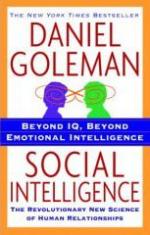|
This section contains 538 words (approx. 2 pages at 400 words per page) |

|
Social Intelligence: The New Science of Human Relationships Summary & Study Guide Description
Social Intelligence: The New Science of Human Relationships Summary & Study Guide includes comprehensive information and analysis to help you understand the book. This study guide contains the following sections:
This detailed literature summary also contains Topics for Discussion on Social Intelligence: The New Science of Human Relationships by Daniel Goleman.
"Social Intelligence: The New Science of Human Relationships" is a non-fiction book written by the award-winning psychologist and journalist Daniel Goleman. In many ways this book is meant to be a companion piece to the "New York Times" best-seller "Emotional Intelligence: Why It Can Matter More Than IQ". The book examines the relationship between neuroscience and human interactions. Goleman finds that we are "wired to connect", and examines the impact are personal relationships have on every aspect of our lives.
Goleman defines Social Intelligence as being knowledgeable about both our interpersonal relationships and in how we act in them as well. He makes a point to distinguish between a self-serving con man and the genuine caring acts we need to have healthy, loving relationships. Goleman uses his own research and life-experiences, as well as the research, life-experiences, and anecdotal evidence of others to continually make his point about the impact our social and private relationships have on our lives. Whether it is bumping into a stranger on the street, or how often our mother's held us as infants, Goleman shows just how our social interactions define us.
In the first few chapters Goleman makes a distinction between the high and low neural pathway. The low road, as the name suggests, is more instinctual and emotion-based. The low road process non-verbal information, such as the body-language and facial expressions of the person we are talking to. On the contrary, the high road revolves more around communication, adaptation, and the ability to recall past experiences. After thoroughly explaining these two different pathways, Goleman uses both of them throughout the rest of the book to illuminate and reinforce his points.
Social Intelligence has six separate sections, each of which has Goleman breaking down the neuroscience of various human interactions. In the first section Goleman addresses human's basic needs to connect with one another. In the next section he breaks down the character traits that lead us to have unhealthy relationships. including the "dark triad: that often lead to some of the greatest instances of evil. In the third section Goleman takes on the ageless 'nature versus nurture' debate. Goleman doesn't chose a side on this hot-button issue, instead he uses neuroscience to show how both play in a role in the type of people we become.
In the fourth section, Goleman looks at how human's neurological system reacts to being in love. In one of the more illuminating parts of the section, Goleman shows that being in love activates the same sectors of the brain as heroin does! In the fifth section, he examines the effects that personal relationships have on our health. While it may seem obvious, positive relationships have a tremendous effect on our health, while negative relationships lead to stress and the numerous health concerns that come with it. In the final section of the book, Goleman examines how this new information on our social relationships could help change our personal and professional lives. Utilizing all the information that he has just gone over, Goleman also wonders what our world might look like if we placed healthy social relationships as the most important part of our lives, and as a society as a whole.
Read more from the Study Guide
|
This section contains 538 words (approx. 2 pages at 400 words per page) |

|



